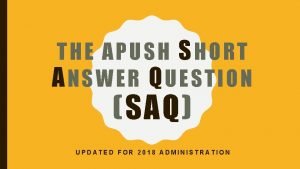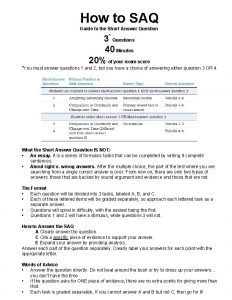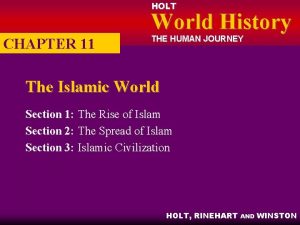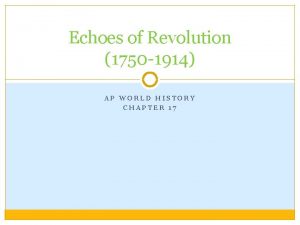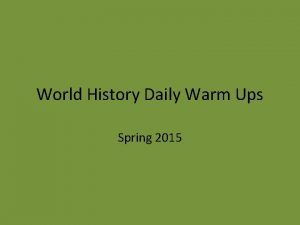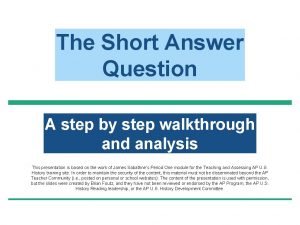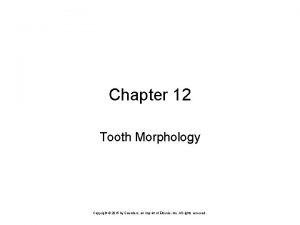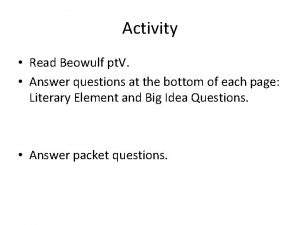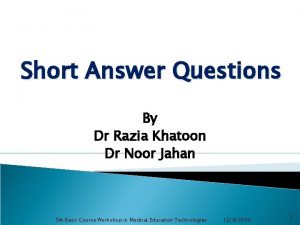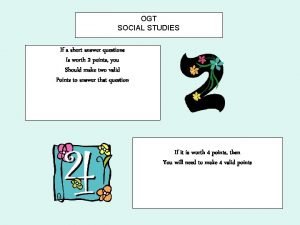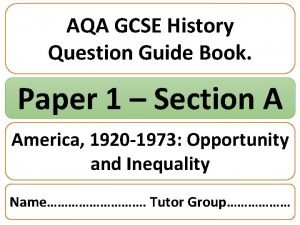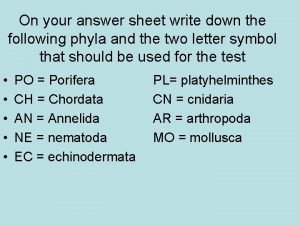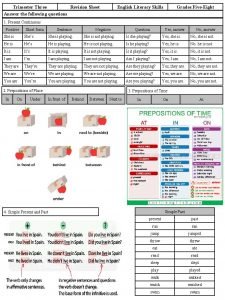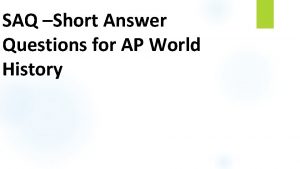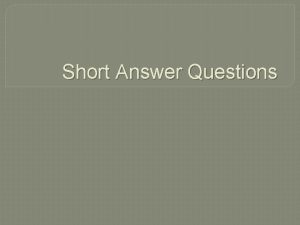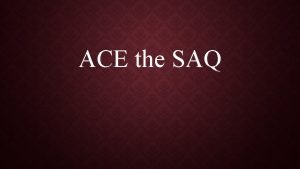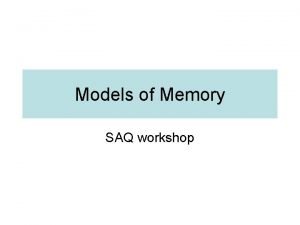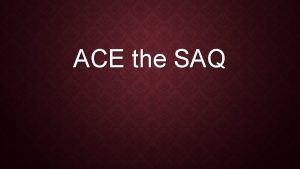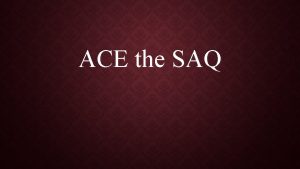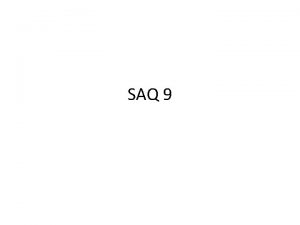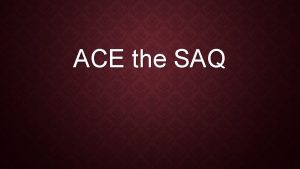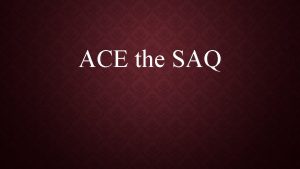SAQ Short Answer Questions for AP World History








































- Slides: 40

SAQ –Short Answer Questions for AP World History

What are the SAQs? SAQs comprise 20% of the Exam score SAQs can be taken from any unit 3 questions total

Why SAQ? The SAQs allow students to use knowledge taught in their unique courses to answer broad questions derived from the Key Concepts, which also assess the students’ use of various historical thinking skills. “Students may employ a wide variety of evidence drawn from the particular content of their AP World History course and materials. ” (College Board)

Why SAQ? Provides teachers more flexibility to teach their own content, and for the use of different textbooks across the country. Increased emphasis on development of historical thinking skills. Puts WHAP in line with AP US History and AP European History

What is an SAQ? The short answer question requires students to accurately answer a question briefly, specifically, and accurately. Generally speaking students are able to answer questions with fewer sentences

Scoring Complete sentences. Correct or incorrect. 1 point for each part = 0 -3 points

Tips Does require complete sentences All 3 parts of the question must be answered. Usually broken into 3 parts a, b, and c, but sometimes part a or part b will have 2 questions within—it always asks 3 questions—so read carefully. Limited space (a one page box with 23 lines) in which to write their answers. Anything written outside of the box will not be scored.

Tips Read question carefully. Annotate the question and rephrase the question as your topic sentence (remember no thesis sentence necessary). Complete Sentences Do NOT bullet (bullets=zero points).

Tips Does not require a thesis statement Students give enough information to answer the question, but not write an essay. At least 2 of the 4 questions will include a stimulus of some kind: photo, political resources, chart, graph, or one or more documents (primary or secondary)

Tips Directly answer the question. Use the language of the prompt! (always) Pay close attention to what the question is asking of you: look for key action words such as describe, analyze, identify, explain, etc. Answer everything the question asks of you: you may have to do more than one thing such as “identify and explain. ”

Tips Look for plurals—asking you do more than one thing: reason vs. reasons; cause vs. causes. If it’s plural you must do 2! You may not see many of these in SAQs, but be on the lookout. Use active verbs! Don’t write outside the space—you should have enough space—don’t panic!

Tips Experts differ on whether you should label your answers. I recommend you label a), b), and c) for ease of understanding. Readers will read the question in such a way as to give you credit where credit is due, and not to nitpick where you provide your answer (although it must be IN THE BOX).

ACE the Question A-Answer the question (this is the assertion or claim). C—Cite specific factual evidence E—Explain how the evidence proves the assertion

Answer, Cite, Explain Source: Hammurabi, The Oldest Code of Laws in the World, the Code of Laws Promulgated by Hammurabi, King of Babylon, 2285 -2242, B. C. (Edinburgh: T. & T. Clark, 1911) 1. If a man weaves a spell and puts a ban upon another man and has not justified himself, he that wove the spell upon him shall be put to death. 2. If a man has put a spell upon another man and has not justified himself, he upon whom the spell is laid shall go to the holy river. He shall plunge into the holy river, and if the holy river overcomes him, he who wove the spell upon him shall take to himself his house. If the holy river makes that man to be innocent, and has saved him, he who laid the spell upon him shall be put to death. He who plunged into the holy river shall take to himself the house of him who wove the spell upon him. 3. If a man, in a case pending judgment, has uttered threats against the witnesses, or has not justified the word that he has spoken, if that case be a capital suit, that man shall be put to death. 4. If he has offered corn or money to the witnesses, he shall himself bear the sentence of that case A) Explain what aspects of life the "Code of Hammurabi" controlled, and give two examples. B) Connect the "Code of Hammurabi" to another set of laws in another region and/or time period and give one example how they are similar

Part A Answer, cite explain A. The aspects of life covered by the Code of Hammurabi are those involving religious views on individuals and involving judgements in courts of law. C. the placing of spells and holy rivers mentioned in laws one and two illustrate religious views and powers of humans and natural phenomena and the bribery illustrated in law #4 illustrates corn or money for false testimony. E. The Babylonians had asserted a special relationship with their Gods and , therefore, needed to control individuals manipulating power by weaving spells. Also the laws regulating bribery of witnesses illustrate a need for fair trials early in history to ensure justice is carried out.

Part B Answer, cite explain A. The Code of Hammurabi is quite like the 12 tables of Roman law in that they both illustrate the need for societies to ensure justice and regulate harsh penalties for violation C. The capital punishments (death) of the code of Hammurabi is like the law under paterfamilias in Rome where if a child strikes their father , they would be thrown from the tarpian rock. E. The need to regulate relationships and the desire to prevent crimes through fear, specific deterrence ( kid will never strike Dad again if thrown) or general deterrence ( other kids will think before striking) helps to maintain law and order in both Babylonian and Roman societies

SAQ World History The Egyptian and Mesopotamian civilizations in the first wave civilizations originated at roughly similar periods in world history, but they evolved in distinctly unique ways for difference. A. Identify and explain a reason for ONE difference in the Egyptian and Mesopotamian political systems. B. Identify and explain a reason for ONE similarity in the Egyptian and Mesopotamian political systems. C. Identify and explain a reason for ONE difference or similarity in Egyptian and Mesopotamian culture.

Scoring Guide: 0 -3 points One point for identifying and explaining how and why Egyptian and Mesopotamian civilizations were different politically in the period of the first wave civilizations. One point for identifying and explaining how and why Egyptian and Mesopotamian civilizations were similar politically in the period of the first wave civilizations. One point for identifying and explaining how and why Egyptian and Mesopotamian cultures were different or similar in the period of the first wave civilizations.

SAQ about Classical China- Era 2. 2 Short Answer Question- (SAQ) Historical Thinking Skill- Change and Continuity Over Time “The Han is one of China’s great historical dynasties. Like the Qin, the Han emperors ruled over an enormous and unified territory, but very different from the Qin, they were able to sustain their rule – despite a brief interruption – for over four centuries… the Han stands as the longest era of Chinese history in which a single hereditary line of rulers controlled the government. “ -Professor Robert Eno, University of Indiana

A) Identify and explain ONE way in which the rule of state government of the Han Dynasty was a continuity of the Qin Dynasty. B) Identify and explain TWO ways in which the rule of state government of the Han Dynasty changed from the Qin Dynasty.

SAQ Recent discoveries suggest that the adoption of agriculture, supposedly our most decisive step toward a better life, was in many ways a catastrophe from which we have never recovered. With agriculture came the gross social and sexual inequality, the disease and despotism, that curse our existence. At first, the evidence against this revisionist interpretation will strike twentieth century Americans as irrefutable. We’re better off in almost every respect than people in the Middle Ages, who in turn had it easier than cavemen, who in turn were better off than apes. Just count our advantages. We enjoy the most abundant and varied foods, the best tools and material goods, some of the longest and healthiest lives, in history. Most of us are safe from starvation and predators. We get our energy from oil and machines, not from out sweat.

There at least three sets of reasons to explain the findings that agriculture was bad for health. First, hunter-gatherers enjoyed a varied diet, while early farmers obtained most of their food from one or a few starchy crops. The farmers gained cheap calories at the cost of poor nutrition. Second, because of dependences on a limited number of crops, farmers ran the risk of starvation if one crop failed. Finally, the mere fact that agriculture encouraged people to clump together in crowded societies, many of which then carried on trade with other crowded societies, led to the spread of parasites and infectious disease. Epidemics couldn’t take hold when populations were scattered in small bands that constantly shifted camp. Jared Diamond, Discover Magazine, 1999

Identify and explain ONE specific historical example that supports Diamond’s argument about the importance of the Agricultural Revolution. Identify and explain ONE specific historical example that challenges Diamond’s argument about the importance of the Agricultural Revolution. Identify and explain ONE way in which scholarly disciplines outside of history have contributed to the scholarly perspectives described by Diamond.

Directions Read the source and complete the following items. Double Underline Diamond’s Thesis or Argument Single Underline the pieces of evidence that Diamond used to support his argument Part (a): Identify and explain ONE specific historical example that supports Diamond’s argument about the importance of the Agricultural Revolution.

How to Earn the Point for Part (a): Write down any specific historical examples that you can think of that would support Diamond’s argument: • Early River Valley Civilizations, such as ancient Egypt, became highly stratified with food producers and manual laborers often placed in the bottom of the social hierarchy. • Dependence on a small number of crops can reduce the diversity of one’s diet. Smaller physical size in early farming societies, such as Mesopotamia and Egypt bears witness to this development. • The devastation caused by the Black Death was due in part to increased trade and interaction of peoples, as well as greater population density in cities brought about by the development of agriculture. • The Agricultural Revolution led to dependency on one or a small number of dominant crops. This could be disastrous in times of famine, such as during the Irish Potato Famine.

Ways points can be missed for part (a): • Fails to recognize that Diamond is arguing that agriculture had negative health and social effects. (Misinterprets the argument) • Addresses one of the negative effects of the Agricultural Revolution, but fails to connect it to a specific historical example. • Response is vague or over generalized.

Sample Student Response (A) “Jared Diamond claims that the Agricultural revolution was a negative impact on human development. He states that it caused society to become unfair and clumped together, which allowed the spread of disease. This is supported by the Bubonic plague, which killed nearly a third of Europe’s population. This would not have happened if humans were still hunter gatherers and spread out. ” Should this response earn the point for part (a)?

Should this response earn the point for part (a)? “Jared Diamond claims that the Agricultural revolution was a negative impact on human development. He states that it caused society to become unfair and clumped together, which allowed the spread of disease. This is supported by the Bubonic plague, which killed nearly a third of Europe’s population. This would not have happened if humans were still hunter gatherers and spread out. ” Should this response earn the point for part (a)? YES Explain your choice: Correctly interprets Diamond’s argument Provides a specific historical example that supports Diamond’s argument

Part (b): Identify and explain ONE specific historical example that challenges Diamond’s argument about the importance of the Agricultural Revolution Write down any specific historical examples that challenge Diamond’s argument: • The increased production of food through agriculture allowed for the specialization of labor in early River Valley Civilizations, which led to greater intellectual and technological advancements, such as written language and metallurgy. • The Agricultural Revolution allowed for the stabilization of the food supply, such as the development of vast granaries and store houses in ancient Rome that were able to feed its citizens in troubled times. • The Agricultural Revolution allowed for the building of permanent settlements that gave rise to civilizations and large states, such as the city-states of Mesopotamia or the urban centers of Harappa and Mohenjo Daro in the Indus Valley.

Ways points can be missed for part (b): • Fails to challenge Diamond’s argument that agriculture had negative health and social effects. (Misinterprets the argument) • Addresses one of the positive effects of the Agricultural Revolution but fails to connect it to a specific historical example. • Response is vague or too general.

Sample student response for part (B): “However, it is the surplus of food that allows for specialization. Varying jobs create culture, arguably the best part about civilization. Religion, art, science, math, language – all of these stem from not having to gather food all day long. Explain your choice: Correctly interprets Diamond’s argument, but does not connect these developments to a specific historical example.

Part (c): Identify and explain ONE way in which scholarly disciplines outside of history have contributed to the scholarly perspectives described by Diamond . Archeology has led to recovery of human remains that demonstrate greater tooth decay, lower bone density, and the smaller size of early farmers as opposed to hunter-gatherers. Anthropological studies of modern hunter-gatherer societies have revealed greater gender equality among many of these groups than is believed to have been found among agricultural and settled people throughout history. Medical studies related to the spread of disease demonstrate that epidemics are more likely to spread in the presence of larger groups of people in frequent contact with one another.

What is Social Science? * Definition of Social Science: a major category of academic disciplines, concerned with society and the relationships among individuals within a society. It in turn has many branches, each of which is considered a "social science". The main social sciences include economics, political science, human geography, demography and sociology. In a wider sense, social science also includes some fields in the humanities such as anthropology, archaeology, psychology, history, and linguistics.

Ways points can be missed for part (C): Fails to state the discipline or field of inquiry that complimented the historical argument. Addresses field of inquiry, but does not adequately or clearly address how the discipline would contribute to the argument.

Sample student response for part (C) “One way that scholarly disciplines outside of history contributed to Diamond’s perspective is through the study of equality. Those people who have developed a knowledge of and recognition of the causes of inequality would have contributed. ” Should this response earn the point for part ? No, Does not identify a specific scholarly discipline that would corroborates Diamond’s argument

Student Sample #1: Practice Scoring Student Response Scoring Guidelines A specific example to support the argument being made a) is the use of a caste system in India. This caste system provided “gross social and sexual inequalities” that made people’s lives unbearable, specifically the untouchables. The untouchables were regarded as next to dirt. Identify and explain ONE specific historical example that supports Diamond’s argument about the importance of the Agricultural Revolution. Score A historical example to challenge the claim of agriculture having negative effects is the rapid growth of the population due to agriculture. Agriculture provided an abundance of food that supported the population. 0 Identify and explain ONE specific historical example that challenges Diamond’s argument about the importance of the Agricultural Revolution. 1 0 Identify and explain ONE way in which scholarly disciplines outside of history have contributed to the scholarly perspectives described by Diamond. 1 Score Archeologists (? ) have contributed to the perspective of Diamond because new things would be discovered that could completely change the point of view of some people. Score a) a) 0 1

Student Sample #1 Score Results: a) Identify and explain ONE specific historical example that supports Diamond’s argument about the importance of the Agricultural Revolution. 0 – Fails to earn 1 point for part a. Explanation: It fails to earn 1 point for part a. The response attempts to describe the use of the caste system in India as an example of social inequality, but fails to explain how the caste system might have been a result of the Agricultural Revolution. In order to earn a point for part a, it might have suggested that the transition toward farming and pastoralism contributed to patterns to inequality and social stratification, which formed the basis for the caste system in India.

Student Sample #1 Score Results: b) Identify and explain ONE specific historical example that challenges Diamond’s argument about the importance of the Agricultural Revolution. 0 – Fails to earn 1 point for part b. Explanation: It does not earn 1 point for part b. The response attempts to explain agriculture’s role in providing an abundance of food, which supported population growth. However, this explanation does not address a specific historical example to provide evidence for this claim. Suggesting that the creation of a food surplus in the Fertile Crescent or Nile River Valley supported larger families, population growth, and eventual urbanization would have been an effective way to earn this point.

Student Sample #1 Score Results: c) Identify and explain ONE way in which scholarly disciplines outside of history have contributed to the scholarly perspectives described by Diamond. 0 – Fails to earn 1 point for part c. Explanation: The response fails to earn 1 point for part c. It mentions that archeology may have contributed to Diamond’s perspective, but the way in which this field of study might have done so is neither specific nor sufficiently explained. Explaining that archeology might have revealed the increasing social inequalities or dietary deficiencies brought about in the transition towards agriculture would have allowed the response to earn this point.

NAME ____________ DATE ______ PERIOD _____ SCORE ______ SAQ SCORING RUBRIC – Topic: ______________ QUESTION A Full Credit Earned Common Issues Points Earned �Answers Question: direct response – makes a claim that can be proved. (In Stimulus Based Prompt - May “snag” a word but NOT Quote). � �Doesn’t use Key Words from Question/Prompt �Relies on Quote from prompt �Wrong time period �Wrong location �Cites Evidence: defines or describes the claim (support answer with SFI [Specific Factual Information] from OUTSIDE the Prompt –learned from class readings, discussions, activities) �Missing evidence/reason/event/example �Random evidence (littering) not connected to Answer �Not specific �Off topic �Expands/Explains Evidence (connect the dots! How does the evidence support/prove answer/assertions? ) �Vague (attempts but doesn’t elaborate) �No connection between evidence & answer �No interpretation �Doesn’t draw conclusion Doesn’t answer question (incorrect)
 Tall + short h
Tall + short h Saq questions
Saq questions What is history short answer
What is history short answer Ap world history short answer questions
Ap world history short answer questions Saq short answer question
Saq short answer question Saq answer example
Saq answer example Ap world history chapter 25 africa and the atlantic world
Ap world history chapter 25 africa and the atlantic world Bad world tour
Bad world tour Saq answer sheet
Saq answer sheet Saq-2:
Saq-2: Saq answer example
Saq answer example Holt world history the human journey
Holt world history the human journey World history jeopardy
World history jeopardy Abolitionist movement ap world history
Abolitionist movement ap world history World history warm up questions
World history warm up questions World history warm up questions
World history warm up questions Romeo and juliet unit test review
Romeo and juliet unit test review Death of a salesman act 1 questions
Death of a salesman act 1 questions Short answer questions examples
Short answer questions examples Recognize developmental disorders of the dentition
Recognize developmental disorders of the dentition Crq questions examples
Crq questions examples Discussion questions for the crucible act 1
Discussion questions for the crucible act 1 Look at the picture ask and answer
Look at the picture ask and answer Chapter 12 tooth morphology short answer questions
Chapter 12 tooth morphology short answer questions Why does beowulf plan the tower so carefully?
Why does beowulf plan the tower so carefully? How to answer short response questions
How to answer short response questions The crossover short answer questions
The crossover short answer questions Look at the film stills and discuss the questions
Look at the film stills and discuss the questions Apes writing
Apes writing Answer of this question
Answer of this question Short answer questions
Short answer questions Higher history evaluate the usefulness
Higher history evaluate the usefulness Aqa history paper 1
Aqa history paper 1 Higher history source questions
Higher history source questions On your answer sheet answer the following questions
On your answer sheet answer the following questions In your answer sheet answer the following questions
In your answer sheet answer the following questions In pairs answer the questions add your questions
In pairs answer the questions add your questions Fspos vägledning för kontinuitetshantering
Fspos vägledning för kontinuitetshantering Typiska drag för en novell
Typiska drag för en novell Tack för att ni lyssnade bild
Tack för att ni lyssnade bild Returpilarna
Returpilarna




